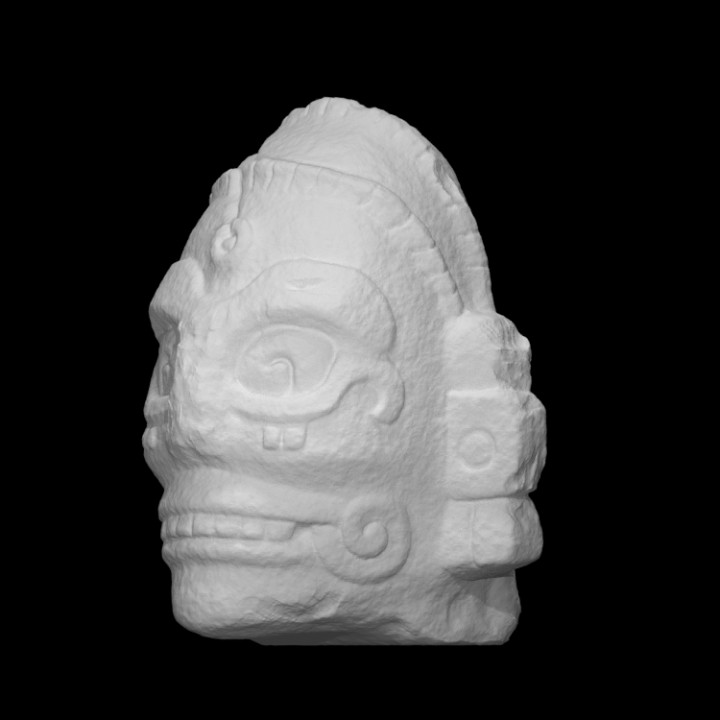
Head of Chahk, a Rain God
myminifactory
This monumental head carved from limestone depicts a supernatural being whose skeletal features define its subject. Large earflares and a beaded headband adorn its appearance, while long hair is indicated by deep incisions flowing down the reverse side of the head. A circular boss dominates the forehead, likely representing a round jewel hanging down from the headband. This detached head probably belonged to an architectural sculpture in high relief as part of a façade or as a free-standing monument. The Maya believed that deities such as the one depicted here had a different type of vision than humans, and artists indicated this through their eyes. The prominent eyes, framed by heavy brows and under-eye lines that terminate in scrolled shapes, have an incised spiral-shaped pupil with traces of red pigment. Combined with the raised dots on the cheeks on either side of the nose, these pupils are markers of godliness in Maya art. The fleshless jaw contains a row of straight, squared teeth and two scrolls emerge from either side of the mouth. The nose is damaged, possibly due to its use in antiquity. Maya artists often depicted supernatural entities with a mixture of attributes or aspects relating different deities, complicating efforts to identify their subjects with particular divine attributes. Most of the depicted features – the skeletal jaw, scrolls emitting from the mouth, earflares, god eyes with spiral pupils, and long hair – associate this image with the rain deity known as Chahk. The under-eye scrolls, however, could also indicate that the artists infused this rain deity with an aspect of the Sun God, whose eyes are often adorned with such motifs. The sculpture of the deity face reflects various stylistic approaches, one of the hallmarks of art from Chichen Itza. The blurring of styles is commonly interpreted as evidence of Early Postclassic Period (ca. AD 900-1200) interaction between the Maya at Chichen Itza and their contemporaries, the Toltecs in Central Mexico. Regardless of its precise identification, the representation was a supernatural portrait meant to draw viewers' attention to the mercurial natural phenomena personified in this fearsome face. Excavated by George Vaillant in 1926 at Chichen Itza, this head was found in a small, south-facing temple nicknamed the "Casa de Cabecitas" or "House of the Small Heads" (Structure 5C3). This head was the finest of many pieces of sculpture in the round from within the temple chamber, including two intact atlantean figures that once supported the lintel of the entryway. The fact that the body associated with this Rain God head was not found may indicate that the inhabitants of the city removed the head from its original location and revered it enough to place it in the small temple. The site of Chichen Itza was designated a UNESCO world heritage site in 1988 and currently receives over two million visitors per year. The city itself was settled in the Early Classic period (ca. A.D. 250-550), but reached its peak of population and architectural constructions in the Late and Terminal Classic periods (ca. A.D. 650-1000). When the Spanish arrived in the 16th century, Diego de Landa noted that local populations near Chichen Itza continued to perform religious ceremonies and throw offerings into the Sacred Cenote, a water-filled sinkhole that was a pilgrimage destination for centuries. Text by James A. Doyle, Ph.D.
With this file you will be able to print Head of Chahk, a Rain God with your 3D printer. Click on the button and save the file on your computer to work, edit or customize your design. You can also find more 3D designs for printers on Head of Chahk, a Rain God.
